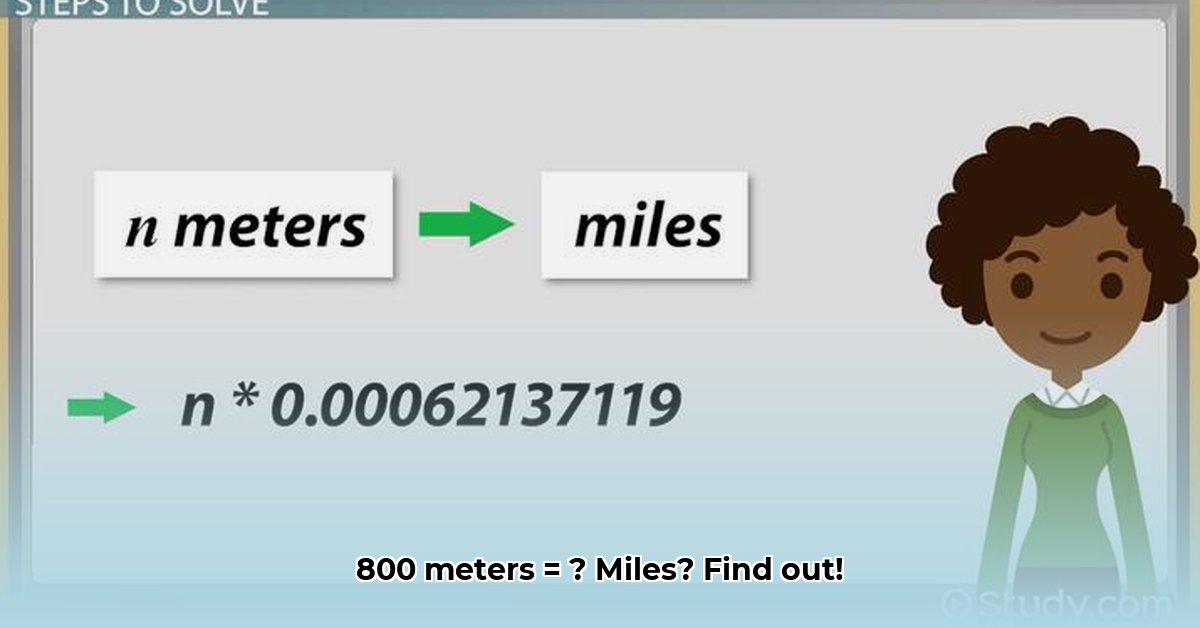Ever wondered how far 800 meters is? It’s approximately half a mile! This comprehensive guide provides everything you need to convert meters to miles, understand their relationship, and apply this knowledge in real-world scenarios. Become a conversion expert and master the metric and imperial systems. For more conversions, check out this helpful guide on feet to meters.
Decoding the Meter-Mile Conversion
Do you need to quickly convert 800 meters to miles for travel, sports, or everyday tasks? It’s a common need, especially when dealing with maps, races, or international projects that mix metric and imperial units. This section breaks down the conversion process with clear explanations and practical examples.
The Core Conversion: Meters into Miles
The fundamental conversion: 800 meters equals roughly half a mile (approximately 0.497 miles). How is this derived? The key is understanding the conversion factor, which links meters and miles, similar to currency exchange rates.
One mile is internationally defined as precisely 1,609.344 meters (equivalent to 5,280 feet). Using this figure, we can accurately convert 800 meters to miles via simple division:
800 meters / 1609.344 meters/mile ≈ 0.497 miles
Therefore, 800 meters is very close to 0.5 miles.
History of Measurement: Meters and Miles
The meter and the mile boast distinct and fascinating histories. Initially, the meter was defined as one ten-millionth of the distance from the Equator to the North Pole. Modernly, it’s defined as the length of the path travelled by light in vacuum during a time interval of 1/299,792,458 of a second, offering unparalleled accuracy.
The mile, with roots in ancient Roman measurements (the Roman mile equaled 5,000 feet), evolved into the statute mile of 5,280 feet in 1593 England. These separate historical paths highlight the necessity for accurate conversion formulas.
Real-World Applications: Why Conversions Matter
Knowing how to convert between meters and miles is incredibly useful. Consider using a fitness tracker that displays your run as 800 meters – knowing that this is roughly half a mile allows you to estimate your workout intensity. Similarly, when interpreting maps or planning travel in countries using the metric system, understanding this conversion provides a vital frame of reference. The ability to convert accurately ensures effective communication and precision across different measurement systems, enhancing our understanding of the world around us.
Avoiding Confusion: “m” for Meters and Miles
A common source of error is the shared abbreviation “m” for both meters and miles. This can easily lead to misinterpretations. To prevent this, the standard abbreviation for miles is “mi”. Always confirm the unit denoted by “m” based on context to ensure accurate understanding and prevent calculation errors.
Exploring Different Types of Miles
While this guide focuses on the standard mile (statute mile), recognize that other types of miles exist, each with a slightly different length. The nautical mile, used in maritime and aviation contexts, is one example. Understanding the specific type of mile is crucial for precise calculations in specialized fields.
Quick Conversion Table
Here is a table providing instant conversions for common distances:
| Meters | Miles (Approximate) |
|---|---|
| 400 | 0.25 |
| 800 | 0.5 |
| 1000 | 0.62 |
| 1600 | 1 |
| 2000 | 1.24 |
| 5000 | 3.11 |
| 10000 | 6.21 |
Further Learning
Continue to expand your knowledge of measurement systems and conversions. Investigate various unit types, explore the complete history of measurement, and master advanced conversion methods. Understanding measurement offers endless opportunities for learning and broadens your global perspective. This knowledge empowers you to use both metric and imperial units with confidence.
















